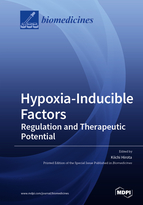Hypoxia-Inducible Factors: Regulation and Therapeutic Potential
A special issue of Biomedicines (ISSN 2227-9059). This special issue belongs to the section "Cell Biology and Pathology".
Deadline for manuscript submissions: closed (30 April 2021) | Viewed by 56036
Special Issue Editor
Interests: hypoxia biology; cancer; metabolism; RNA-Seq; anesthesiology; bioinfomatics
Special Issues, Collections and Topics in MDPI journals
Special Issue Information
Dear colleagues,
Molecular oxygen acts as a final electron transfer molecule in oxidative phosphorylation in mitochondria, is deeply involved in oxygen and energy metabolism, and plays a role as a factor in the regulation of iron metabolism, angiogenesis, and vascular tone.
In the late 1980s, a team led by Dr. Gregg L. Semenza in Johns Hopkins University in Baltimore, USA, decided to search for an intracellular factor involved in hypoxia-induced expression of erythropoietin and isolated the cDNA of a transcription factor in 1995. This transcription factor was designated hypoxia-inducible factor 1 (HIF-1). A closely related gene, HIF2A or EPAS1, was identified and cloned in 1997, followed by HIF3A in 1998. A series of genes, such as those coding for various glycolytic enzymes, glucose transport protein, vascular endothelial growth factor, hematopoietic factor erythropoietin, are regulated by HIFs at the transcriptional level. Thus, HIFs play a role beyond the activation of "hypoxia-inducible" genes. We could say that the term “HIF” also stands for "Highly Involved Factor".
We invite research and review papers in various areas of oxygen biology research that focus on, but not exclusively, the fundamental understanding of HIFs signaling pathways and related gene expression profiling, epigenetic regulation, diagnostic, prognostic, and pharmacogenomic biomarkers, molecular targets driving the regulation of human physiology and pathophysiology, clinical trials with new agents, and validation in animal models.
We hope that this Special Issue will reflect our exciting era with respect to the research on HIFs and its applications in medicine and health science.
Prof. Kiichi Hirota
Guest Editor
Manuscript Submission Information
Manuscripts should be submitted online at www.mdpi.com by registering and logging in to this website. Once you are registered, click here to go to the submission form. Manuscripts can be submitted until the deadline. All submissions that pass pre-check are peer-reviewed. Accepted papers will be published continuously in the journal (as soon as accepted) and will be listed together on the special issue website. Research articles, review articles as well as short communications are invited. For planned papers, a title and short abstract (about 100 words) can be sent to the Editorial Office for announcement on this website.
Submitted manuscripts should not have been published previously, nor be under consideration for publication elsewhere (except conference proceedings papers). All manuscripts are thoroughly refereed through a single-blind peer-review process. A guide for authors and other relevant information for submission of manuscripts is available on the Instructions for Authors page. Biomedicines is an international peer-reviewed open access monthly journal published by MDPI.
Please visit the Instructions for Authors page before submitting a manuscript. The Article Processing Charge (APC) for publication in this open access journal is 2600 CHF (Swiss Francs). Submitted papers should be well formatted and use good English. Authors may use MDPI's English editing service prior to publication or during author revisions.
Keywords
- hypoxia
- oxygen biology
- hypoxia-inducible factor
- oxygenase
- hydroxylase
- angiogenesis
- metabolism
- cancer
- erythropoiesis
- apoptosis
- iron metabolism
- mitochondria
- genomics
- proteomics
- bioinformatics
- metagenome







